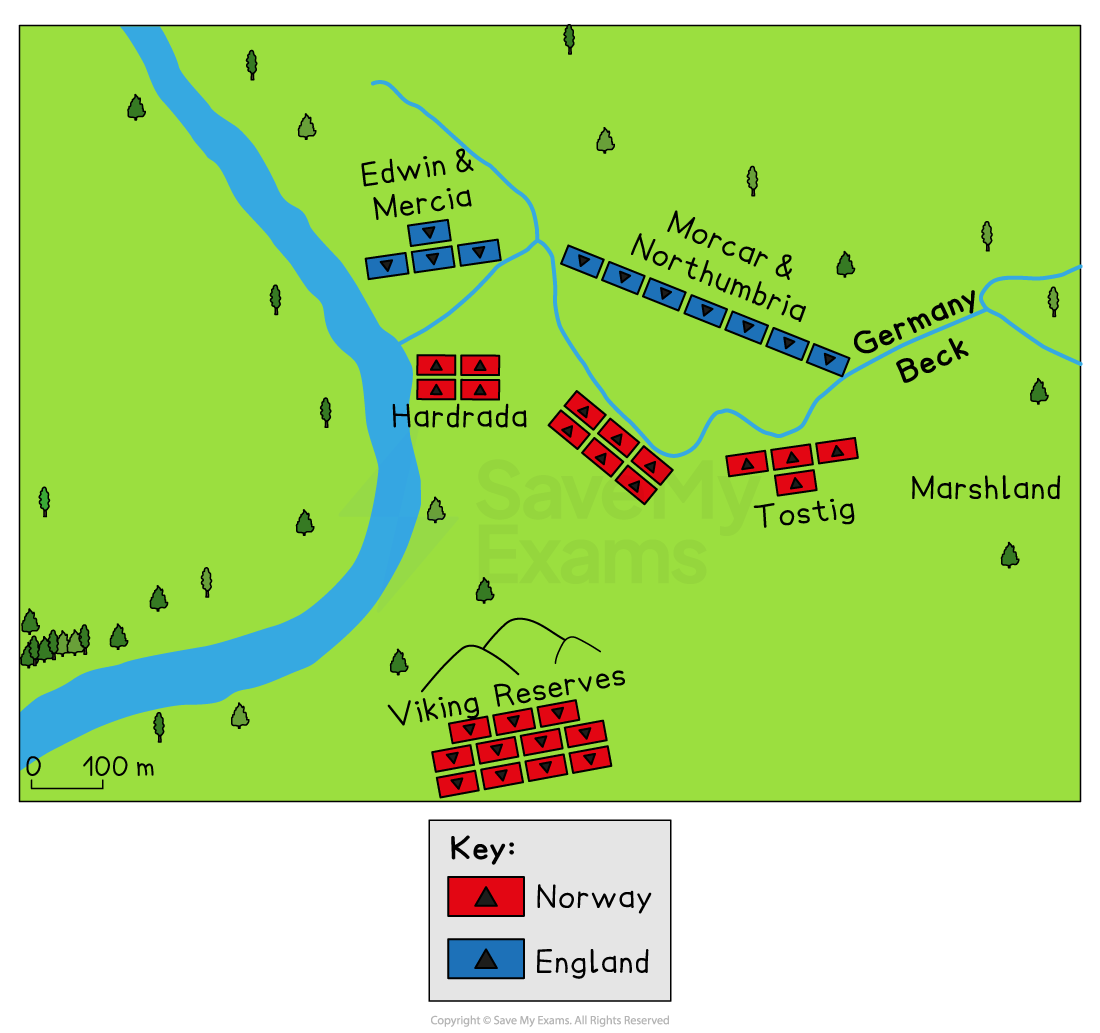Battle of Stamford Bridge (AQA GCSE History): Revision Note
Exam code: 8145

Summary
Harold Godwinson knew his coronation would lead to challenges from the other claimants to the throne. He quickly prepared to defend against an invasion and suspected that the first attack would come from Normandy. After months of waiting, he disbanded his forces to collect the harvest.
However, the threat had not gone and September 1066, saw both the Vikings and Normans prepare to invade. The Vikings were the first to arrive and they captured the city of York after a victory over Anglo-Saxon forces at the Battle of Fulford Gate. Harold Godwinson then marched north, defeated the Viking army and killed Hardrada at the Battle of Stamford Bridge.
Harold Godwinson’s Defences
Harold Godwinson knew that his coronation would be likely to lead to invasions from both Norway and Normandy
As a result, he ordered the construction of a navy
He also called on his nobles to assemble an army to fight off the potential invasions
Anglo-Saxon kings did not have large standing armies
They relied on a small group of professional soldiers known as housecarls
In times of emergency, the king would assemble his thegns who would bring their villeins and thralls to form an irregular army
This force of peasants and farm labourers was known as the fyrd
By the start of summer, the fyrd were several thousand strong and
They were placed in key positions on the south coast to defend against the expected invasion from William of Normandy
By September, the invasion from Normandy had still not come
Harold could not afford to keep thousands of peasants away from their fields indefinitely
When the time came to bring in the harvest, Harold decided to disband the fyrd and send the peasants back to their villages
Just days later, William moved his invasion fleet north along the Normandy coast to make the crossing of the English Channel quicker and easier
At the same time, Harald Hardrada, accompanied by Tostig Godwinson and around 8,000 Viking warriors was sailing south from Norway to invade the north of England
Harald Hardrada’s invasion
In September 1066, 300 Viking ships sailed up the River Ouse and landed at the small village of Riccall, about 10 miles from York
As the Vikings began their overland march to York they were confronted by an Anglo-Saxon army
The Anglo-Saxon forces were led by Harold Godwindon’s brothers-in-law: Edwin, Earl of Mercia and Morcar, Earl of Northumbria
The Battle of Fulford Gate
The Battle of Fulford Gate took place on 20 September 1066

The 3,500 Anglo-Saxon warriors managed to take the Vikings by surprise and their attack was initially successful
The Vikings regrouped and their greater numbers led them to victory
The Anglo-Saxon forces were scattered but Edwin and Morcar managed to escape with their lives
The Vikings had won the battle but had also sustained many casualties among their warriors
Estimates suggest that 15% of both armies were killed
York soon fell under Viking control and Hardrada and Tostig took several local nobles and their families as hostages
Hardrada did this to prevent rebellions as any uprisings would lead to the deaths of the hostages
Who won the Battle of Stamford Bridge?
AWAITING IMAGE
The arrival of Hardrada in York had led Harold Godwinson to reassemble his army immediately and to march north
The 200 miles were covered in less than a week and Harold arrived at York with his men on 25th September
This was quicker than Hardrada had expected, and the Vikings were caught by surprise in their camp near Stamford Bridge
The Vikings were not assembled or ready for battle and some warriors were caught without their armour
After a prolonged battle, the Vikings were eventually routed
Both Hardrada and Tostig were killed and it was a stunning victory for Harold Godwinson
A major threat to his rule had been removed
The threat from William of Normandy remained
Examiner Tips and Tricks
You could get an ‘Explain the importance’ question relating to the Battle of Stamford Bridge. When answering this question it is important to address the importance of its causes (the succession crisis after the death of Edward the Confessor) and the importance of its consequences (the ending of the Viking claim to England’s Throne and its effect on the Anglo-Saxon forces that marched for hundreds of miles and suffered many casualties)

Unlock more, it's free!
Did this page help you?